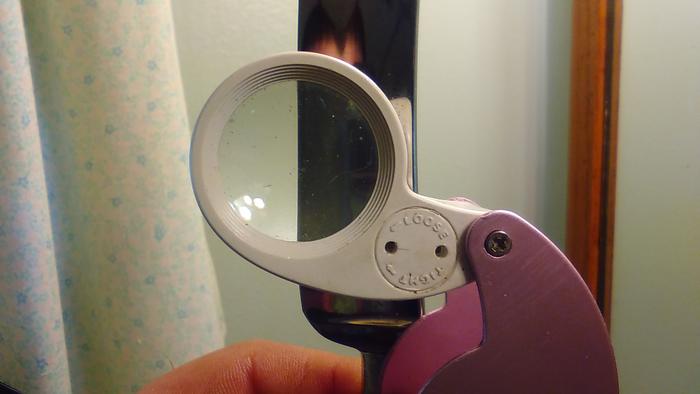Results 1 to 10 of 32
Thread: Using loupe for honing
Hybrid View
-
07-01-2018, 07:40 AM #1Senior Member



- Join Date
- Mar 2012
- Location
- Thunder Bay, Ontario, Canada
- Posts
- 17,251
Thanked: 3222
A loupe is an aid to honing and trick to using one is to know what you are looking at and for. In post #2 the link should give you a good idea what you are looking at and for. You then have to figure out what strokes to apply to correct any deficiencies that you see. That can take some time to learn how to interpret what you are seeing and how to apply corrections if needed. At least it took me awhile to be able to use a loupe successfully.
It helps to view the edge under a bright light source. For that purpose I have an old goose neck table lamp with a bright LED bulb placed at the end of the hone I am using. It is bent over the hone so I can see how the water is moving at the edge of the blade while honing and to check the edge with a loupe.
BobLife is a terminal illness in the end
-
The Following User Says Thank You to BobH For This Useful Post:
boz (08-12-2018)
-
07-01-2018, 01:42 PM #2

I use a 30x loupe. But I only use it for checking for micro chips.
I look at the the edges from the sides at a 90°angle. This allows me to see if the scratches are uniform, and reach completely to the apex. Also, if you have a well lighted wall you'll be able to see the micro chips, by twisting the blade one way or the other till the bevel looks black to the eye, then move up n down the edge with the loupe to see
 Mike
Mike
-
07-01-2018, 02:01 PM #3Senior Member




- Join Date
- Feb 2013
- Location
- Haida Gwaii, British Columbia, Canada
- Posts
- 14,401
Thanked: 4822
The creation of the apex is super important. For that I look nearly straight down on the apex and watch for any white lines or sparkles, as they indicate places wher the apex does not create a perfect or complete ‘V’. A nice bright light source is needed.
https://straightrazorpalace.com/honi...ggestions.html
There are some good pictures in this thread too.It's not what you know, it's who you take fishing!
-
07-01-2018, 02:13 PM #4

I use a Belomo loupe 10x, especially useful if you restore razors where most of your honing will start at a new bevel set, I personally like to look at the bevel quite closely at the bevel set stage If I'm happy with what I'm seeing then I can put the bevel away for the rest of the progression.
“Wherever you’re going never take an idiot with you, you can always find one when you get there.”
-
07-01-2018, 03:23 PM #5Senior Member




- Join Date
- Dec 2012
- Location
- Egham, a little town just outside London.
- Posts
- 3,739
- Blog Entries
- 2
Thanked: 1075
One thing to bear in mind is that all loupes are not made equal. Celticcrusaders Belomo 10 x loupe is a 1st class loupe that is a lot more powerful than a cheap Chinese one at double the magnification.
I have a cheap 30 x loupe like Outbacks that does the job just fine.Last edited by markbignosekelly; 07-01-2018 at 03:26 PM.
-
07-01-2018, 04:05 PM #6

I have an 11x achromatic triplet (analogous to a 10x Bausch & Lomb Hastings achromatic triplet loupe) that I use to check the edge and bevel. For the bevel, I look at it with reflected light on the blade, with the light source at around a 45-degree angle to the blade. The edge, I view in silhouette with the light source behind it. 10x-11x suits me fine. A higher magnification like 20x (B&L Hastings achromatic triplet loupe) brings me too close to the bevel; and the edge viewed in silhouette there can open up a never-ending quest for visual perfection rather than the quality of the shave itself.
Last edited by Brontosaurus; 07-01-2018 at 04:14 PM.
Striving to be brief, I become obscure. --Horace
-
07-01-2018, 11:47 PM #7Senior Member

- Join Date
- Sep 2010
- Location
- Calgary, Alberta
- Posts
- 160
Thanked: 2
Thanks for advice. The biggest problem I find is getting the light at the right angle to see things clearly, but I think I have the idea.
Do all the striations need to be in the same direction from each grit?
Euclid440 said on one post to make the last 10 strokes on the 8K at 90* to edge. What is the reason for this?Last edited by binder; 07-02-2018 at 12:51 AM.
-
12-24-2018, 12:27 PM #8

I have a few different loupes, I have the cheapie ones like Glen used in one of his vids as it has a pretty decent view with an led light and then I have Belolo 10x triplet but to be honest the cheapie one is the one I reach for and I just use it on inital inspection for chips and such but after coming off the 1K I rarely use one.
"A Honer's adage "Hone-Shave-Repeat"
~William~


 106Likes
106Likes LinkBack URL
LinkBack URL About LinkBacks
About LinkBacks






 Reply With Quote
Reply With Quote